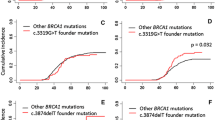Abstract
A recent report based on 68 families, including 17 with mutations in BRCA1, suggested that there was an excess of female offspring born to BRCA1 mutation carriers. We have examined the gender ratio among offspring of 511 mutation carriers from 116 BRCA1 families, 77 and 39 from Australia and the United States, respectively. We found no evidence for a significant deviation from the expected proportion of female offspring in the Australian pedigrees, but there was an excess of female offspring in pedigrees from the USA. Ascertainment bias probably explains this bias, rather than a link with X-chromosome inactivation as previously suggested, because the families from the USA were ascertained for the purposes of linkage studies whereas those from Australia were ascertained through Familial Cancer Clinics to which they had been referred for clinical genetic counseling and mutation testing.
Similar content being viewed by others
References
M Hoya Particlede la JM Fernandex A Tosar et al. (2003) ArticleTitleAssociation between BRCA1 mutations and ratio of female to male births in offspring of families with breast cancer, ovarian cancer, or both JAMA 290 929–31 Occurrence Handle10.1001/jama.290.7.929 Occurrence Handle12928470
Struewing JP, Hartge P, Wacholder S et al. (2004). BRCA1 and sex ratio. Eur J Hum Genet Advance online publication.
R Osborne J Hopper J Kirk et al. (2000) ArticleTitleKConFaB: a resource for studies into the genetics, epidemiology, biology, pathology and psychosocial aspects of breast cancer families. I. Identification and characterisation of eligible families Med J Aust 172 463–4 Occurrence Handle1:STN:280:DC%2BD3czivVKgsQ%3D%3D Occurrence Handle10870547
O Serova M Montagna D Torchard et al. (1996) ArticleTitleA high incidence of BRCA1 mutations in 20 breast-ovarian cancer families Am J Hum Genet 58 42–51 Occurrence Handle1:CAS:528:DyaK28XkvFCntQ%3D%3D Occurrence Handle8554067
OM Serova S Mazoyer N Puget et al. (1997) ArticleTitleMutations in BRCA1 and BRCA2 in breast cancer families: are there more breast cancer-susceptibility genes? Am J Hum Genet 60 486–95 Occurrence Handle1:CAS:528:DyaK2sXhvFGjtLk%3D Occurrence Handle9042907
N Puget D Torchard OM Serova-Sinilnikova et al. (1997) ArticleTitle1-kb Alu-mediated germ-line deletion removing BRCA1 exon 17 Cancer Res 57 828–31 Occurrence Handle1:CAS:528:DyaK2sXhs1Kju7c%3D Occurrence Handle9041180
S Mazoyer N Puget L Perrin-Vidoz et al. (1998) ArticleTitleA BRCA1 nonsense mutation causes exon skipping Am J Hum Genet 62 713–5 Occurrence Handle10.1086/301768 Occurrence Handle1:CAS:528:DyaK1MXlvFeg Occurrence Handle9497265
N Puget OM Sinilnikova D Stoppa-Lyonnet et al. (1999) ArticleTitleAn Alu-mediated 6-kb duplication in the BRCA1 gene: a new founder mutation? Am J Hum Genet 64 300–2 Occurrence Handle10.1086/302211 Occurrence Handle1:CAS:528:DyaK1MXht1elsL8%3D Occurrence Handle9915971
N Puget D Stoppa-Lyonnet OM Sinilnikova et al. (1999) ArticleTitleScreening for germ-line rearrangements and regulatory mutations in BRCA1 led to the identification of four new deletions Cancer Res 59 455–61 Occurrence Handle1:CAS:528:DyaK1MXntFOisw%3D%3D Occurrence Handle9927062
N Puget S Gad L Perrin-Vidoz OM Sinilnikova et al. (2002) ArticleTitleDistinct BRCA1 rearrangements involving the BRCA1 pseudogene suggest the existence of a recombination hot spot Am J Hum Genet 70 858–65 Occurrence Handle10.1086/339434 Occurrence Handle1:CAS:528:DC%2BD38XivFClur0%3D Occurrence Handle11880951
SAS Institute. SAS System for Windows. Release 8.02. Cary, NC.
I Gal S Sadetzki R Gershoni-Baruch B Oberman et al. (2004) ArticleTitleOffspring gender ratio and the rate of recurrent spontaneous miscarriages in Jewish women at high risk for breast/ovarian cancer Am J Hum Genet 74 1270–5 Occurrence Handle10.1086/421442 Occurrence Handle1:CAS:528:DC%2BD2cXks1Cqsrc%3D Occurrence Handle15116316
Author information
Authors and Affiliations
Corresponding author
Rights and permissions
About this article
Cite this article
Chenevix-Trench, G., Sinilnikova, O.M., Suthers, G. et al. Ratio of male to female births in the offspring of BRCA1 and BRCA2 carriers. Familial Cancer 4, 73–75 (2005). https://doi.org/10.1007/s10689-004-2102-y
Received:
Accepted:
Issue Date:
DOI: https://doi.org/10.1007/s10689-004-2102-y




